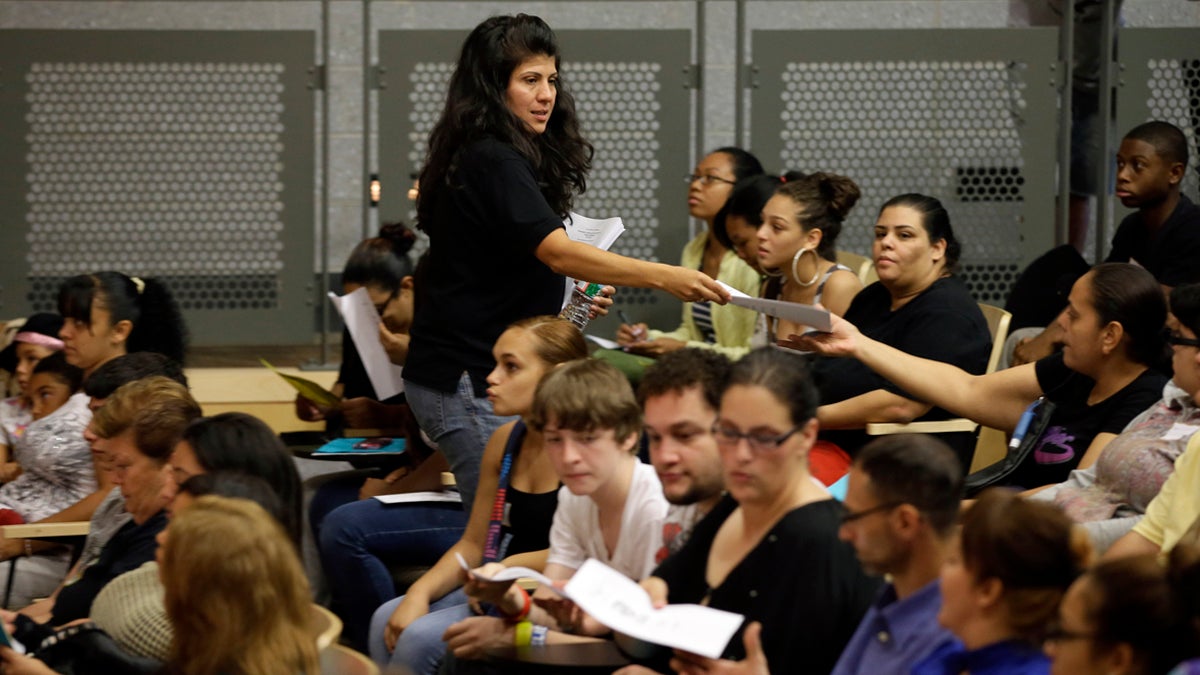After ‘leveling,’ Philly’s split-grade classes reduced by half

The leveling process is said to relieve overcrowding in several schools and provide better learning environments for students (Matt Slocum/AP Photo, file)
The Philadelphia School District has been “leveled.”
As a result, the district has reduced the number of its controversial split-grade classrooms, made up of students in different grades, from about 100 to 50.
With leveling, the district aligns staffing projections made in the summer with enrollment realities in the fall.
If more students show up at a school than the district had projected, and fewer students show up at another school, the district shuffles faculty from one to the other in an attempt to keep student-to-teacher ratios within the contracted maximums.
The district’s contract with the Philadelphia Federation of Teachers stipulates that kindergarten through third-grade teachers should have no more than 30 students, and teachers in grades four through 12 have no more than 33.
This year – in the wake of layoffs and turnover which has reduced the district’s staff by about 3,000 – students, parents and faculty at schools across the district expressed grievances over a host of academic issues including split-grade classrooms and class sizes that have far exceeded contracted maximums.
To address both issues, the district has transferred 139 teachers while hiring an additional 29.
Last school year, 82 teachers were transferred during the leveling process and 42 teachers were added.
Although leveling is now complete, district officials could not confirm how many classes will remain above contracted-maximum levels.
“While the overall level of changes is slightly higher than last year, this process will relieve overcrowding in several schools, providing better learning environments for our students,” said Philadelphia Schools Superintendent William Hite. “Leveling is an opportunity to address enrollment concerns early in the school year.”
Of the 50 remaining split-grade classrooms, anecdotal evidence suggests that many have been newly split by the leveling process. This means, for instance, that – starting the eighth week of school – the district has moved some second-graders into classrooms of first- or third-graders with new teachers.
Education advocates such as Parents United for Public Education founder Helen Gym say this has contributed to creating “one of the most chaotic school openings that we’ve seen since the state takeover.”
“While we’re glad that the number of split-grades went down, parents especially are very angry at the fact that more split-grades were created in the process,” she said.
The school district could not confirm how many of the 50 split-grade classrooms were newly split by leveling.
The leveling process was originally to be completed by Oct. 15, but was pushed back, the district said, “to best match limited resources with urgent student and school needs.”
District continues to seek labor concessions
The district seeks to reduce class sizes further and eliminate additional split-grade classrooms by asking for $133 million in concessions from its labor partners.
Jerry Jordan, president of the Philadelphia Federation of Teachers, said asking for union givebacks has become the district’s sole “mantra.”
“It is certainly unreasonable for anyone to expect that the employees of the school district or members of the PFT are going to be responsible for funding the school district,” said Jordan. “That’s the responsibility of the commonwealth of Pennsylvania.”
Although the district recently received an additional $45 million in funding from the state, Hite has said that none of this money will be used to remedy split-grade classes or classroom overcrowding.
The district has not yet released detailed accounting for how the money will be spent. In public meetings last week, Hite offered a sketch that includes additional funds for special-education services, guidance counselors (80), music instruction, spring sports, as well as $10 million in payments to the city’s charter schools.
“It is unimaginable that the district could receive $45 million and that a significant number of our schools could actually end up worse off through loss of essential teaching staff,” wrote a coalition of parents organized by Gym’s Parents United in a letter to Hite last week.
The Philadelphia School District expected 135,231 students to fill its classrooms this year, but actual enrollment dipped to 131,463 – a 3,768-student decrease.
Where these students went, the district says it does not know.
The city’s charter schools are expected to release enrollment figures later this week.
WHYY is your source for fact-based, in-depth journalism and information. As a nonprofit organization, we rely on financial support from readers like you. Please give today.


